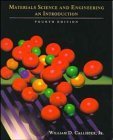Synopsis
This text treats the important properties of the three primary types of materials - metals, ceramics, and polymers - as well as composites, and the relationships that exist between the structural elements of these materials and their properties. Emphasis is placed on mechanical behaviour and failure, including techniques that are employed to improve the mechanical and failure characteristics in terms of alteration of structural elements. Furthermore, individual chapters discuss corrosion, electrical, thermal, magnetic, optical properties, and economic/environmental/societal issues. The book offers a balanced coverage of metals, polymers, and ceramics with selections on composite materials. It discusses corrosive, electrical, thermal, magnetic, mechanical, and optical properties of materials. Early chapters treat atomic bonding and crystal structures of metals, as review material for students who have had a complete year of freshman chemistry. Further material is devoted to the mechanical properties, the mechanisms of deformation, and failure, respectively, for metals with a detailed discussion of elementary fracture mechanisms.
Présentation de l'éditeur
The latest edition of this bestselling textbook treats the important properties of three primary types of material––metals, ceramics, polymers––as well as composites. Describes the relationships that exist between the structural elements of these materials and their characteristics. Emphasizes mechanical behavior and failure along with techniques used to improve the mechanical and failure properties in terms of alteration of structural elements. Individual chapters discuss each of the corrosion, electrical, thermal, magnetic, and optical properties plus economic, environmental, and societal issues. Features a design component which includes design examples, case studies, and design type problems and questions.
Les informations fournies dans la section « A propos du livre » peuvent faire référence à une autre édition de ce titre.
